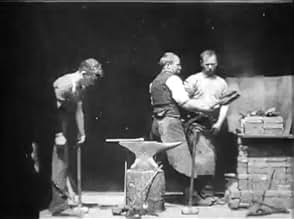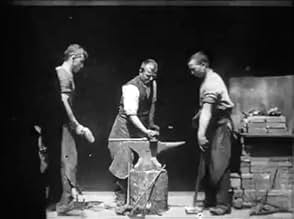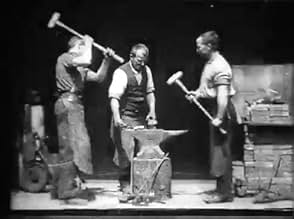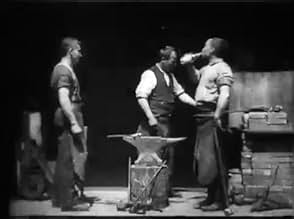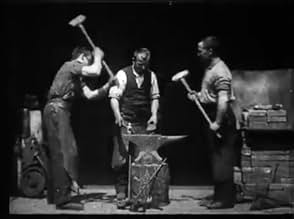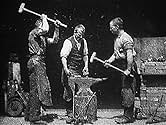IMDb-BEWERTUNG
6,2/10
2948
IHRE BEWERTUNG
Füge eine Handlung in deiner Sprache hinzuThree men hammer on an anvil and pass a bottle of beer around.Three men hammer on an anvil and pass a bottle of beer around.Three men hammer on an anvil and pass a bottle of beer around.
- Regie
- Hauptbesetzung
- Auszeichnungen
- 1 wins total
Charles Kayser
- Blacksmith
- (Nicht genannt)
Empfohlene Bewertungen
This is one of the (at least) two films that the Edison Company exhibited in their nearly completed peephole viewer, the Kinetoscope, for the first time to the public at the Brooklyn Institute of Arts and Sciences on 9 May 1893. The other, which hasn't received comparable historical attention, was "Horse Shoeing" (1893). This historical importance is why the US Library of Congress has made it the earliest film selected to its National Film Registry. The Edison Company, headed by primary filmmakers and inventors William K.L. Dickson and William Heise, had been successfully producing films as early as 1890. Additionally, they had already given a public demonstration with a proto Kinetoscope on 20 May 1891 to some 150 members of the National Federation of Women's Clubs. The film shown was "Dickson Greeting", where Dickson tips his hat--he moves.
The historical significance of primacy doesn't stop there for "Blacksmith Scene", though. Its May 1893 showing tested the Kinetoscope's commercial viability. On 14 April 1894, the first public Kinetoscope parlour opened in New York--their first commercial exhibition. Included among the 10 films that made up the original program was "Blacksmith Scene" (referred to as "Blacksmiths"). "Horse Shoeing" was there, too. Of the more interesting films also shown that day were: "Barber Shop" (1894), which was another interesting early use of the "Black Maria" as a (now) conventional studio set with a proto fictional narrative. And, "Sandow" (1894) flexing and posing in a loincloth offered an example of the voyeuristic and sexualized potential for the new medium--accentuated by the individualized peephole viewer. On 17 October of the same year, "Blacksmith Scene" (referred to as "Blacksmith Shop") was also part of the first Kinetoscope program in England.
In addition to its primacy in the commercial exhibition of motion pictures, "Blacksmith Scene" is also a historically noteworthy film in how it's staged to form an artificial setting and fictional narrative. As primitive as it appears today, it was probably the most complex film made to date. Before its filming, Dickson and Heise had filmed brief displays of sport, such as boxing, which would prove a very popular subject in early American film. Other experiments such as "Dickson Greeting" (1891) and "A Hand Shake" (1892) were mere recordings of the motion of gestures and weren't released commercially. So too were the early experiments by others like Louis Le Prince and Woodsworth Donisthorpe. Thus, the history of film as a commercial industry begins with "Blacksmith Scene".
Although with a slightly less restrictive definition of "motion pictures", one could argue that Eadweard Muybridge, Ottomar Anschütz, Émile Reynaud and others beat Thomas Edison to it. Nevertheless, this film is a departure from anything made before.
The film, "Blacksmith Scene", consists of a stationary long shot lasting around half a minute of three blacksmiths who take a brief break from blacksmithing to pass around a bottle of beer. It's primitive--a silhouette of a man standing in front of the camera and on the left-hand side of the frame is briefly seen before, I assume, being told to move out of the picture. The trademark sunlit shadows and black background of the "Black Maria" become an overused setting in the early Edison films, but in regards to the time of this film, it wasn't hackneyed yet. Nevertheless, there are three actors (in actuality, employees of Edison who worked on the invention of the Kinetoscope) pretending to be blacksmiths, and they act out a fictional scene of blacksmithing.
Moreover, as Charles Musser has pointed out, the film's narrative is nostalgic--recalling a bygone era when drinking while working was commonplace. In this sense, the film is a reconstruction of the past--something that the Edison Company would take further in "The Execution of Mary, Queen of Scots" (1895).
"Blacksmith Scene" received widespread distribution--was, in fact, one of the first such films to be seen by many, and as such, was one of the earliest films to influence other filmmakers and to encourage remakes. The Lumière Company remade it as "Les Forgerons" (Blacksmiths at Work) in 1895. Also with the title "Blacksmiths at Work" is James Williamson's film made in 1898. The Edison Company, itself, remade it in 1895 (actually their third blacksmithing scene--the first being a now-lost experiment in 1891). Although not influenced by these commercial films (or vice versa), blacksmithing was also the subject of scientific analyses around this time in films of Albert Londe, as well as Étienne-Jules Marey and Charles Fremont.
(Note: This is the second in a series of my comments on 10 "firsts" in film history. The other films covered are Traffic Crossing Leeds Bridge (1888), Annabelle Serpentine Dance (1895), The Execution of Mary, Queen of Scots (1895), La Sortie des usines Lumière (1895), L' Arroseur arose (1895), L' Arrivée d'un train à La Ciotat (1896), Panorama du Grand Canal vu d'un bateau (1896), Return of Lifeboat (1897) and Panorama of Eiffel Tower (1900).)
The historical significance of primacy doesn't stop there for "Blacksmith Scene", though. Its May 1893 showing tested the Kinetoscope's commercial viability. On 14 April 1894, the first public Kinetoscope parlour opened in New York--their first commercial exhibition. Included among the 10 films that made up the original program was "Blacksmith Scene" (referred to as "Blacksmiths"). "Horse Shoeing" was there, too. Of the more interesting films also shown that day were: "Barber Shop" (1894), which was another interesting early use of the "Black Maria" as a (now) conventional studio set with a proto fictional narrative. And, "Sandow" (1894) flexing and posing in a loincloth offered an example of the voyeuristic and sexualized potential for the new medium--accentuated by the individualized peephole viewer. On 17 October of the same year, "Blacksmith Scene" (referred to as "Blacksmith Shop") was also part of the first Kinetoscope program in England.
In addition to its primacy in the commercial exhibition of motion pictures, "Blacksmith Scene" is also a historically noteworthy film in how it's staged to form an artificial setting and fictional narrative. As primitive as it appears today, it was probably the most complex film made to date. Before its filming, Dickson and Heise had filmed brief displays of sport, such as boxing, which would prove a very popular subject in early American film. Other experiments such as "Dickson Greeting" (1891) and "A Hand Shake" (1892) were mere recordings of the motion of gestures and weren't released commercially. So too were the early experiments by others like Louis Le Prince and Woodsworth Donisthorpe. Thus, the history of film as a commercial industry begins with "Blacksmith Scene".
Although with a slightly less restrictive definition of "motion pictures", one could argue that Eadweard Muybridge, Ottomar Anschütz, Émile Reynaud and others beat Thomas Edison to it. Nevertheless, this film is a departure from anything made before.
The film, "Blacksmith Scene", consists of a stationary long shot lasting around half a minute of three blacksmiths who take a brief break from blacksmithing to pass around a bottle of beer. It's primitive--a silhouette of a man standing in front of the camera and on the left-hand side of the frame is briefly seen before, I assume, being told to move out of the picture. The trademark sunlit shadows and black background of the "Black Maria" become an overused setting in the early Edison films, but in regards to the time of this film, it wasn't hackneyed yet. Nevertheless, there are three actors (in actuality, employees of Edison who worked on the invention of the Kinetoscope) pretending to be blacksmiths, and they act out a fictional scene of blacksmithing.
Moreover, as Charles Musser has pointed out, the film's narrative is nostalgic--recalling a bygone era when drinking while working was commonplace. In this sense, the film is a reconstruction of the past--something that the Edison Company would take further in "The Execution of Mary, Queen of Scots" (1895).
"Blacksmith Scene" received widespread distribution--was, in fact, one of the first such films to be seen by many, and as such, was one of the earliest films to influence other filmmakers and to encourage remakes. The Lumière Company remade it as "Les Forgerons" (Blacksmiths at Work) in 1895. Also with the title "Blacksmiths at Work" is James Williamson's film made in 1898. The Edison Company, itself, remade it in 1895 (actually their third blacksmithing scene--the first being a now-lost experiment in 1891). Although not influenced by these commercial films (or vice versa), blacksmithing was also the subject of scientific analyses around this time in films of Albert Londe, as well as Étienne-Jules Marey and Charles Fremont.
(Note: This is the second in a series of my comments on 10 "firsts" in film history. The other films covered are Traffic Crossing Leeds Bridge (1888), Annabelle Serpentine Dance (1895), The Execution of Mary, Queen of Scots (1895), La Sortie des usines Lumière (1895), L' Arroseur arose (1895), L' Arrivée d'un train à La Ciotat (1896), Panorama du Grand Canal vu d'un bateau (1896), Return of Lifeboat (1897) and Panorama of Eiffel Tower (1900).)
Very similar to Newark Athlete, but this time the clip runs much more smoothly. Nothing jerks, and there's only one cut. The mixing of alcohol and work also makes this slightly comical.
All right, so it's short on plot. But just the fact of this Edison-studio produced film is enough to make it an award-winner. It doesn't have the same pathos as the Edison clip of men dancing used to such great effect in "The Celluloid Closet," but how can you not love a century-old example of "Miller Time"?
'Blacksmith Scene (1893)' was one of the first commercially-exhibited motion pictures, filmed in April 1893 and first screened publicly at the Brooklyn Institute on May 9, 1893. The set-up is pretty simple: three blacksmiths (actually employees of Thomas Edison) start hammering away at a heated metal rod and an anvil, before pausing to pass around a bottle of beer. The acting from two of the performers is convincing enough; the third blacksmith, on the left, doesn't even pretend that the beer bottle contains any liquid, briefly pressing the rim to his mouth and then removing it without even the pretence of drinking. The film's first seven seconds have the silhouette of a fourth party blocking the left side of the frame, before somebody presumably told him to get out of the way. While watching this didn't give me the same thrill as the Lumière brothers' 'Arrival of a Train at La Ciotat (1895),' 'Blacksmith Scene' is still an important historical curiosity. I'm grateful that the National Film Registry always remembers to honour and preserve even these apparently-innocuous snippets of cinema history.
This is supposed to be the "first staged narrative in film", although it is really better described as one of the "actualities" that Edison's films were known as, and what ultimately, about 20 years later, was their downfall. Actualities really had no story, they were just glimpses into normal life, and sometimes the weird and fanciful, but none really had a story.
Apparently the guy in the middle is an actual blacksmith and the two assistants are actors. Together they hammer on a heated rod placed on an anvil. Afterwards, the three share a bottle of beer. Both actors had long lives. One lived from 1850-1931. The other, Charles Kayser, lived from 1878-1966, which would have made him only fifteen when this film was made. So he would have lived to see movies grow from these actualities, to features, the coming of sound, then TV, then even color TV.
Apparently the guy in the middle is an actual blacksmith and the two assistants are actors. Together they hammer on a heated rod placed on an anvil. Afterwards, the three share a bottle of beer. Both actors had long lives. One lived from 1850-1931. The other, Charles Kayser, lived from 1878-1966, which would have made him only fifteen when this film was made. So he would have lived to see movies grow from these actualities, to features, the coming of sound, then TV, then even color TV.
WUSSTEST DU SCHON:
- WissenswertesThe mixing of work and alcohol was commonplace in the early 19th century, especially amongst heavy laborers. By the 1890's, however, the practice had died away. The use of the bottle of beer in this film is intended to invoke a sense of comic nostalgia of a bygone era.
- VerbindungenFeatured in Edison: The Invention of the Movies (2005)
Top-Auswahl
Melde dich zum Bewerten an und greife auf die Watchlist für personalisierte Empfehlungen zu.
Details
- Laufzeit1 Minute
- Farbe
- Sound-Mix
- Seitenverhältnis
- 1.33 : 1
Zu dieser Seite beitragen
Bearbeitung vorschlagen oder fehlenden Inhalt hinzufügen

Oberste Lücke
By what name was Blacksmith Scene (1893) officially released in India in English?
Antwort
